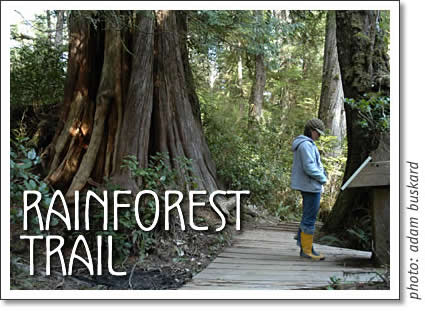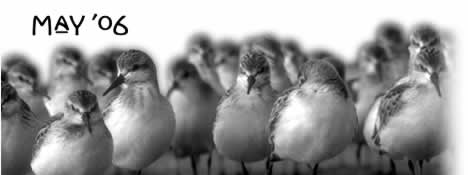
Pacific Rim National Park Reserve: The Rainforest Trail
by Sean McCarroll, Tofino
As you descend into the Rainforest trail, the temperature drops. The air becomes moist and heavy. Sunlight is filtered out and the large ancient trees that tower above make you feel slightly insignificant and uneasy. It is almost eerily silent.
There are a thousand different shades of green in the temperate rainforest, and walking the trail is like stepping back into an almost prehistoric landscape. The foliage is so thick and so obviously rich in life that you are constantly forced to wonder at what types of wildlife are hiding in its cover.
The trail consists of two loops on either side of the Pacific Rim Highway. Both are about 1.2 kilometres in length, but plan on taking extra time (about 40 minutes per loop) as there are fascinating interpretive signs along the trail that explain how the forest regenerates itself and how the various organisms that call this dark, damp place home interact and depend on each other.
n equal amount of time will most likely be spent staring in awe at the size of some of the trees you will come across.
Loop B is the gentler of the two trails. It begins at an old clearing where you can see how the forest has started to regenerate itself after being logged. Gradually the forest becomes thicker and you will notice a very obvious drop in temperature and a wet chill in the air as you walk further. Even on a sunny, warm day it feels as though you are walking through a dense, cold fog.
From the clearing, the trail leads through cedars and hemlock and eventually into the old-growth rainforest. All the noises from the busy highway are completely filtered out once you enter the forest, replaced by an almost tangible silence that is broken only by a gentle trickling of water that seems to come from everywhere. Everything looks and smells as if the sun has just come out after a heavy rainstorm.
The trail is primarily a boardwalk, however at one section you will walk across a bridge made from a single fallen old-growth log. The boardwalk will take you across small streams and pools of water dyed brown from the tannins leaking from rotting cedars. It follows winding gullies and there are lookout points where you can see a salmon stream and sections where the forest opens up slightly and the sun is allowed through the thick canopy.
Moss and lichens cling to nearly every surface, and on either side of the trail the forest is a thick tangled web of creeping growth and fallen logs from which new, monstrously large, trees have sprouted. There are at least three ancient giant cedars that can be seen from the trail, including one that is over 800 years old.
On the other side of the highway Loop A is essentially the same type of forest as the one found on Loop B, but this trail will take you deeper down into the gullies. This makes it easier to view the different levels, and the different organisms that exist in them, of a temperate rainforest.
You will see gigantic western red cedar, western hemlock, and amabilis fir. Their branches support vast gardens of ferns, moss, and shrubs that drape from every available surface. Their trunks and branches grow in knotted configurations and intertwine with each other.
Unfortunately the silence of the rainforest of Loop A is often broken by the sound of a busy chainsaw. Pacific Rim National Park is extremely narrow and within 100 metres of Loop A there has been extensive logging along the border of the park.
Both trails are located about 16 kms south of Tofino. There is a parking lot on the western side of the road beside the Rainforest trail sign. Each loop takes about 40 minutes to complete, and both are relatively easy as there is a wooden boardwalk over the entire trail. Loop A has more gullies and stairs than Loop B and neither is wheelchair accessible.
Sean McCarroll is an outdoor and travel writer from Nova Scotia.
Pacific Rim National Park
- Radar Hill
- Schooner Cove Trail
- Shorepine Bog Trail
- South Beach Trail
- Nuu Cha Nulth Trail
- Rainforest Trail
Tofino Hiking & Trails
Tofino Time Magazine May 2006
- Open House on Clayoquot Island
- 4th Annual Tofino Food & Wine Festival
- Tofino tides: Tide table for Tofino May 2006
- Safe Boating in Tofino
- Backyard Birdfeeding in Tofino
- Tofino concerts: Music in May 2006
- Tofino essay: The NOMO cabal
- Tofino Kayaking: Keeping it Together
- Pacific Rim National Park: The Rainforest Trail
- Tofino Yoga: 15-minute Yoga
- Tofino art: Ken Campbell
- Tofino gardening in May 2006
- Events in Tofino: Calendar for May 2006
- Tofino Horoscope for May 2006
- Tofino Profile: Niky Lewis
- Community Directory: Goods & Services in Tofino
Tofino Time Magazine May 2006
- Open House on Clayoquot Island
- 4th Annual Tofino Food & Wine Festival
- Tofino tides: Tide table for Tofino May 2006
- Safe Boating in Tofino
- Backyard Birdfeeding in Tofino
- Tofino concerts: Music in May 2006
- Tofino essay: The NOMO cabal
- Tofino Kayaking: Keeping it Together
- Pacific Rim National Park: The Rainforest Trail
- Tofino Yoga: 15-minute Yoga
- Tofino art: Ken Campbell
- Tofino gardening in May 2006
- Events in Tofino: Calendar for May 2006
- Tofino Horoscope for May 2006
- Tofino Profile: Niky Lewis
- Community Directory: Goods & Services in Tofino
tofino | tofino time | activities | accommodation | events | directory
maps | travel | food | art & artists | photos | horoscope | tides
search | magazine | issues | articles | advertising | contact us
hosted in tofino by tofino.net & studio tofino
© 2002-2014 copyright Tofino Time Magazine in Tofino Canada

